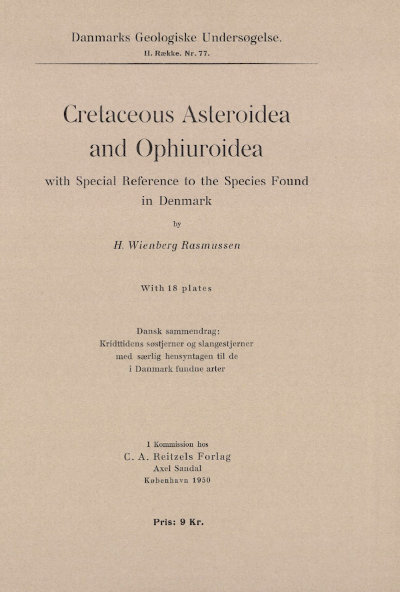Cretaceous Asteroidea and Ophiuroidea with Special Reference to the Species Found in Denmark
DOI:
https://doi.org/10.34194/raekke2.v77.6866Abstract
Knowledge of the Cretaceous asteroids and ophiuroids is extended on the basis of an abundant new fossil material. It is shown that several previously described species are identical. Those asteroids referred to the genera Ravniaster and Milraster are nearly all young individuals of Metopaster. Description of ophiuroids on the basis of the relative frequency of single skeletal parts has shown itself to be an unfortunate method. The Danish, and a few foreign Cretaceous asteroids and ophiuroids are revised on the basis of the new observations. Six new species, five of which are found in Denmark, are described.
The following ontogenctic series have been found:
Rauniaster simplex ==> Mitraster hunteri var. lævis (in part) ==> Metopaster poulsenii ==> Metopaster stevensensis.
Ravniaster virgineus ==> Metopaster tumidus.
Ravniaster lævis ==> Metopaster lævis (= Mitraster hunteri var. lævis in part).
Mitraster compactus ==> Metopaster parkirisoni.
"Mitraster rugatus" ==> Metopaster cingulatus ==> Metopaster uncatus.
Mitraster rugatus ==> Metopaster hunteri (= Mitraster hunteri).
The genera Ravniaster and Mitraster are identical with Metopaster, and Lophidiaster with Astropecten. Recurvaster stevensensis and R. echinatus are identical with R. Radiatus (= Metopaster tumidus var. radiatus). Pycinaster lamberti is identical with P. crassus, Chomataster brünnichi with C. acules, Ophiura fitchii with Ophiomusium subcylindricun, Ophiura parvisentis with O. serrata, and, possibly, Ophiomusium stephensoni with O. danica. The following species are new to science: Recurvaster blackmorei, Chomataster spenceri, Chomataster wrighti, Ophiura? hagenowi, Ophiura? substriata and Asteronyx? ornatus.
Downloads
Published
Issue
Section
License
This article is distributed under a CC-BY 4.0 licence, permitting free redistribution and reproduction for any purpose, even commercial, provided proper citation of the original work. Author(s) retain copyright over the article contents.


